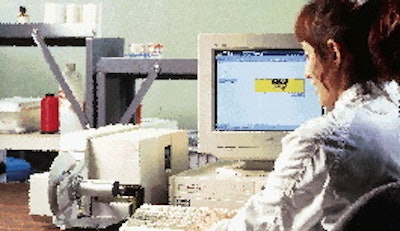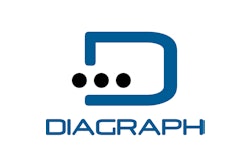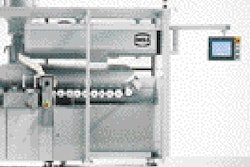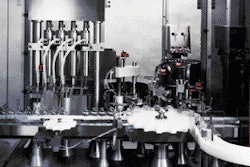
By using a new labeling system, Artel, a maker of test kits for life sciences laboratories, was able to increase its productivity, supply better information on its labels and provide a tamper-evident seal. The Westbrook, ME-based company achieved all of this by installing a Diagraph (St. Louis, MO) printer and Model LA/550 labeler.
"It used to take two employees approximately one hour to label 100 bottles by hand," says Pat Frechette, production manager at Artel. "One employee can now label 150 bottles in approximately seven minutes using the Diagraph labeling equipment."
Artel's chemical samples test and/or calibrate a variety of micro-volume liquid dispensing equipment. These samples are filled into 5-mL glass vials and 8- to 60-mL glass bottles with polypropylene caps from Comar (Buena, NJ). Prior to using the Diagraph machine, Artel printed single labels on a computer printer for the vials and purchased preprinted labels for the bottles. All of these labels were applied by hand. Also, to provide some tamper evidence, Artel manually applied tape over the top portion of the packages after capping. The labels did not include lot codes or expiration dates. Until last year, this wasn't a problem for Artel; the firm would either leave the codes off or write them on the labels by hand. However, as of April 1998, the FDA required that this information be included for all packages.
In 1997, Artel added a combination of Diagraph's Performance Series Software for Windows(TM) to store the label information, a Diagraph Allegro thermal-transfer printer and a Diagraph semi-automatic label applicator to print the information on the labels and apply them to the bottles.
An operator uses the Windows-based software to pull up the exact label that needs to be printed. The label format is shown on the screen, and the operator enters any new information to the label such as expiration date or lot code, and the quantity of labels that need to be printed. Next, the operator takes the roll of pressure-sensitive labels from Reynolds & Reynolds (Portland, ME) and loads them onto the Diagraph LA/550 semi-automatic label applicator. The operator places a vial or bottle on the bottle rollers of the applicator and presses the foot pedal. This triggers the labeler to spin the vial or bottle, thus wrapping the label around the container. Half of the label is on the cap and the other half is on the body of the vial or bottle.
Because the testing instruments and kits are designed for accurate measurement sensitivity, down to one billionth of a liter of liquid, the labels need to be accurate also. The new labels ensure that the tests are used correctly. "The coding on the label enables our customers to easily determine which bottle of the sample solution to use for the size [equipment] they are checking. It also permits the customer to verify that they're using the correct lot code and solution, ensuring that the accuracy and precision of the [equipment] is correctly assessed," says Frechette.
Although Artel had applied tape over the caps and bottles or vials, they could still be opened and retaped. Because Artel now labels over both the cap and the bottle, the integrity of the test is ensured. "The label is used as a safety seal to prevent any tampering with the vial or its contents," says Frechette. "It provides assurance that the tubes and bottles are sealed, secure and have not been opened. Also, it is critical that the vial remain capped so there is no evaporation of liquid inside the tube." The label material is sent preperforated, so the caps are still easy to remove. However, the labels cannot be removed without tearing.
Economic benefits
With the need to test instruments increasing due to problems such as environmental hazards and pathogens in processed food, Artel has seen an increase in its testing kit orders. With the old system, Artel was unable to keep up with the orders. "We were seeing a dramatic increase in our sales volume, as well as the need to lower labor costs," says Frechette. In fact, Frechette says sales have doubled over the past eight months.
The labeler is also helping Artel save $800 a month in labor costs, says Frechette. Those savings are attributable to using one operator to run the labeler rather than having two people label containers by hand.
Frechette says installing the Diagraph equipment has created a win-win situation for everyone involved. "The labeling equipment is user-friendly and requires very little training before use," says Frechette. "Artel and its customers have benefitted greatly by the use of the Diagraph labeling equipment."

























